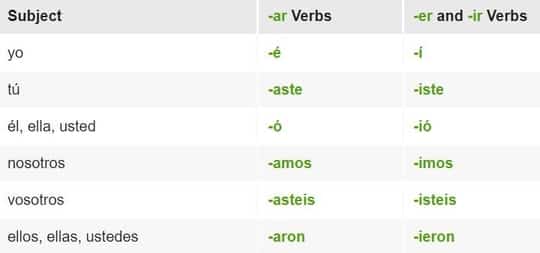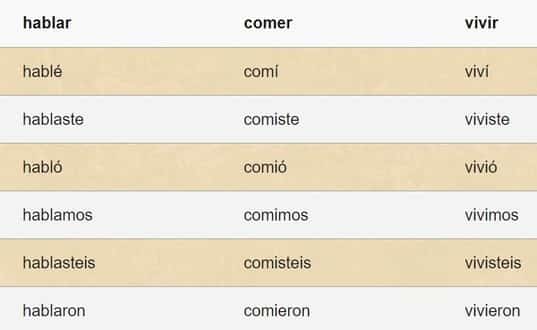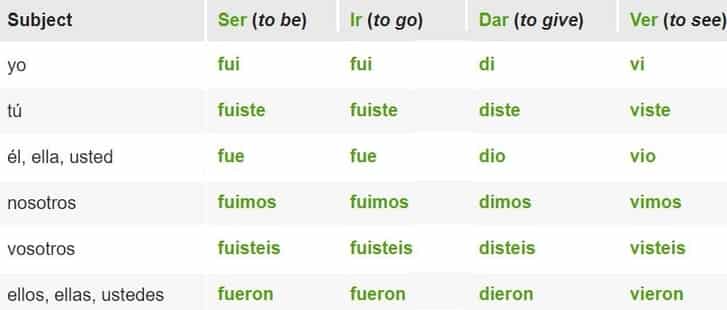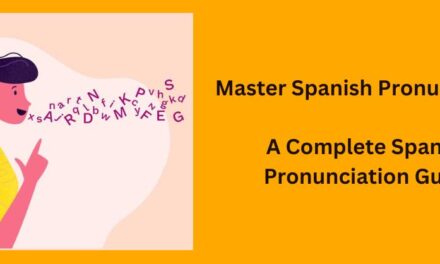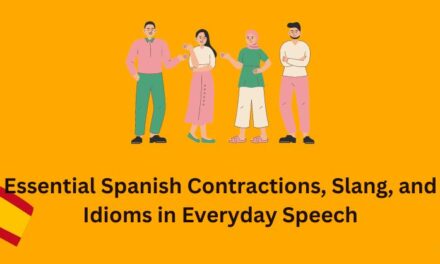Spanish Preterite Tense: Verb Conjugation, Uses and Examples
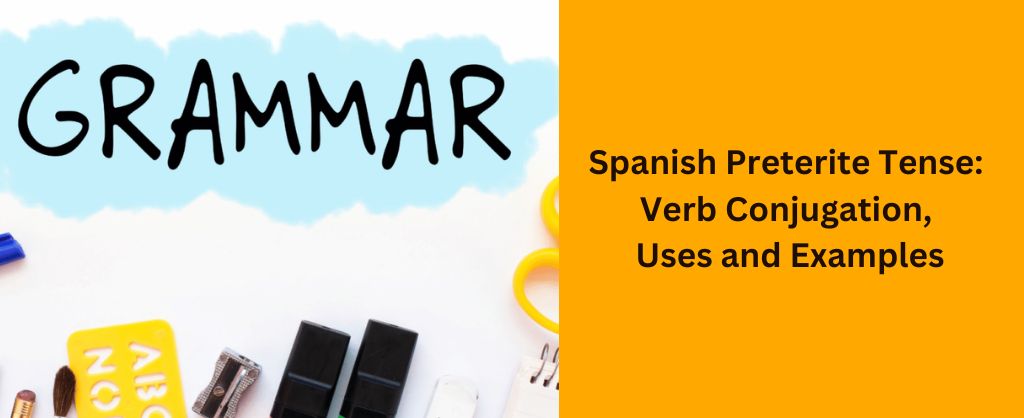
Let’s learn Spanish Preterite Tense
In this article, we’ll explore the preterite tense in Spanish (also called the pretérito or the simple past tense) in a way that makes perfect sentido (Sense).
First, let’s talk about what verb tenses are in general. Tenses indicate when an action takes place. In English, we have the present tense (“I eat”), the past tense (“I ate”), and the future tense (“I will eat”).
As you learn Spanish, you’ll find that it also has present, past, and future tenses. The preterite is one of a few key ways to talk about the past.
So when would you use the preterite tense?
Think of it as the “simple past” – the tense for actions that were completed at a definite point in the past. For example:
“Ayer, yo caminé al parque”- Yesterday, I walked to the park
“Anoche, nosotros cenamos en un restaurante elegante” – Last night, we ate at a fancy restaurant
See how the preterite verbs “caminé” and “cenamos” express actions that occurred at a definite time in the past? The preterite is used for actions that started and finished in the past.
On the other hand, you use the imperfect tense for ongoing or repeated actions in the past. More on that later!
How to conjugate Spanish verbs in the preterite.
First, what does it mean to conjugate a verb? Conjugation is when you take the verb stem and add different endings to indicate who is performing the action (I, you, he/she/it, we, you all, they).
Must-Know Spanish Contractions, Slang, and Idioms
Regular Preterite Verb Endings
In Spanish, verbs have different endings in the preterite compared to other tenses. There are two main conjugation patterns, so memorizing those is key.
- For -ar verbs like “hablar” (to speak), the preterite endings are:
hablé – I spoke hablaste – you spoke habló – he/she/it spoke hablamos – we spoke hablaron – you all/they spoke
- For -er and -ir verbs like “comer” (to eat) and “vivir” (to live), the endings are:
comí – I ate comiste – you ate comió – he/she/it ate comimos – we ate comieron – you all/they ate
viví – I lived viviste – you lived vivió – he/she/it lived vivimos – we lived vivieron – you all/they lived
Get the hang of those two conjugation patterns for preterite verbs and you’re halfway there!
Now let’s look at some helpful memory tips:
- For -ar verbs, think of the endings as forming an A shape: é, aste, ó, amos, aron.
- For -er/-ir verbs, think of the endings as forming an I shape: í, iste, ió, imos, ieron.
- The nosotros (we) and vosotros (you all) endings are always the same: -amos and -aron for -ar, -imos and -ieron for -er/-ir.
- The él/ella/Ud (he/she/you formal) ending is always -ó or -ió.
See how thinking of the endings as forming distinctive shapes can help cement them in your memory?
Another tip is to pay attention to the accent marks, especially for the “yo” form of each verb. The accent falls on the last syllable for -ar verbs (hablé) and the second-to-last syllable for -er/-ir verbs (comí).
Ok, let’s move on to some examples so you can get the hang of using the preterite tense in full sentences:
Example of all three endings -ar, -er, -ir
Hablé, comí y viví. – I spoke, I ate, and I lived.
Note: The first person plural (nosotros) endings for regular -ar and -ir verbs are the same for both the preterite and present tenses.
Cocinamos arroz. – This sentence could mean both, we cooked and we cook rice.
- Siempre Cocinamos arroz. – We always cook rice.
- Ayer Cocinamos arroz. – Yesterday we cooked rice.
More Examples:
“Yo llamé a mi hermana ayer.” – I called my sister yesterday.
“Nosotros no pudimos salir anoche.” – We couldn’t go out last night.
“Ella corrió cinco kilómetros ayer.” – She ran five kilometers yesterday.
“¿Adónde fuiste de vacaciones?” – Where did you go on vacation?
“Ellas eligieron la opción incorrecta.” – They chose the wrong option.
Let’s practice conjugating some regular preterite verbs:
Hablar: Yo hablé – I spoke Tú hablaste – You spoke Ella/Ud. hablaó – She/You (formal) spoke
Comer: Yo comí – I ate Vosotros comisteis – You all ate Ellos comieron – They ate
Escribir: Nosotros escribimos – We wrote Ella escribió – She wrote Uds. escribieron – You all (formal) wrote
Great job! See how the endings change for each subject pronoun? One thing to note is that the preterite only exists in the indicative mood – you won’t find preterite conjugations for nosotros commands, subjunctive, etc.
Now what about irregular preterite verbs that don’t follow the normal -ar, -er, or -ir patterns?
These are verbs like:
Decir – to say/tell Tener – to have Andar – to walk Venir – to come Hacer – to do/make Poner – to put
For these irregular verbs, you simply need to memorize their unique preterite forms. Some examples:
digo – I say
tuve – I had anduve – I walked vine – I came hice – I did/made puse – I put
Below are few most common irregular preterite verbs:
Note: Ser (to be) and Ir (to go) both have exactly same form in Spanish preterite past tense.
- Tú fuiste mesera de este restaurante. – You were a waitress of this restaurant.
- Tú fuiste a la India. – You went to India.
The more you practice using these unique forms, the more natural they’ll become. Try flashcards and quizzing yourself to memorize irregular verbs.
Another important note is that some Spanish verbs undergo a vowel change in the preterite to help distinguish between the preterite and other tenses. These verbs include:
Pensar – to think Prefiero – to prefer Sentir – to feel/regret Dormir – to sleep
For example:
Present: pienso – I think Preterite: pensé – I thought
Present: prefiero – I prefer Preterite: preferí – I preferred
Present: siento – I feel/regret Preterite: sentí – I felt
Make sense? Keeping track of vowel changes is crucial to properly forming the preterite.
Questions and sentences to practice Spanish preterite tense:
- Te fuiste por tu lado. – You went to your side.
- Tú fuiste al cine. – You went to the cinema.
- Nunca fui a la India. – I never went to India.
- Yo no fui. – I did not go.
- No fui ella, esta señora está confundida. – It wasn’t she(her), this lady is confused.
- Ella caminó. – She walked.
- Ellos llegaron a las tres. – They arrived at three o’clock.
- Ayer escribí tres cartas. – Yesterday I wrote three letters.
- Vivimos allí por ocho años. – We lived there for eight years.
- Julia se levantó, se vistió, y salió del hotel. – Julia got up, dressed, and left the hotel.
- Juan caminó en la calle. – Juan walked on the street.
- Yo corrí tres veces. – I ran three times.
- Compré un coche nuevo. – I bought a new car.
- Rob y Julia se casaron. – Rob and Julia got married.
- Kumar nació en Nueva Delhi. – Kumar was born in New Delhi.
- Empezó a nevar en Francia. – It began to snow in France.
- El libro terminó con una sorpresa. – The book ended with a surprise.
- Regresé anoche a las ocho. – I got back last night at eight.
- Vivió en Singapore por dos meses. – He lived in Singapore for two months.
- Leíste este libro el mes pasado. – You read this book last month.
- Effie nació el dos de junio. Effie was born on June second.
- Me levanté, me vestí, y salí para la oficina. – I got up, got dressed, and left for the office.
- Tú entraste, bebiste una taza de café y comiste pollo. – You came in, drank a cup of coffee, and ate chicken.
Let’s recap when you need to use the preterite tense:
- For completed, one-time actions in the past: Fui al cine ayer. (I went to the movies yesterday.)
- To describe specific moments/periods of time in the past: Durante las vacaciones, visitamos un nuevo restaurante. (During the vacation, we visited a new restaurant.)
- To list sequential actions in the past: Primero me levanté, luego me duché y finalmente desayuné. (First I got up, then I showered and finally I ate breakfast.)
- To ask questions about what someone did: ¿Qué hiciste la semana pasada? (What did you do last week?)
So in summary, the Spanish preterite tense allows you to talk about actions that were completed in the past. Learn the two main conjugation patterns, pay attention to accent marks, memorize irregulars, and watch out for vowel changes.
With time and practice, conjugating in the preterite will become segunda naturaleza (second nature).
¡Sigue aprendiendo! (Keep learning!)

